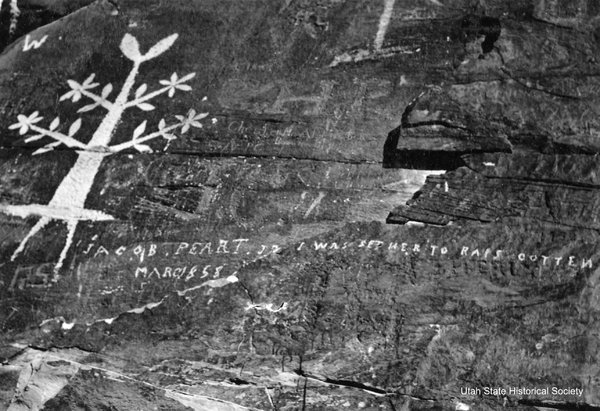Dublin Core
Title
Description
Believing they could “make the desert blossom as the rose,” Mormon settlers expanded into southwestern Utah in the 1850s at the direction of their church's leader Brigham Young. They established the Cotton Mission, hoping to grow enough cotton to ease dependence on outside trade. But the arid landscape challenged their dream of economic self-sufficiency, and the Cotton Mission was a short-lived, futile effort. The colonists found the greatest enemy to their economic success was the volatile Virgin River.
Settlers hoped to grow enough cotton to supply community members’ needs, but the results were disappointing at best. Cotton is a thirsty plant and southwestern Utah receives little rainfall. Hot, dry summers and alkaline soils were challenges on their own. Together with the unpredictable floods of the Virgin River, the Cotton Mission stood little chance of success.
Heavy rains in 1861 washed away some of the first attempts to settle the towns of Grafton, Virgin, and Rockville. Rising waters threatened families, including one settler in Grafton - Mrs. Tenney - who was in active labor with her son when the flood struck and had to be carried to safety. Homes, wagons, food, and furniture were swept away with the river. Once the storm cleared, the damaged properties and crops were covered in mud and in desperate need of repair.
During dry times, the Virgin River is little more than a trickle and insufficient for large agricultural production. The steeply dropping river was also prone to flash flooding that regularly washed away dams and other property. Families struggled to farm even small gardens called “dinner baskets” along its banks because these plots, laid in narrow strips along either side of the river, were highly susceptible to erosion from flooding. It didn’t take long before most settlers packed up and headed for higher, safer ground.
Despite the harsh conditions, there were a few families who remained on the land and continued to plant crops. Ultimately, this persistence led nowhere and the Cotton Mission eventually died amidst the harsh and unforgiving landscape. The unpredictable Virgin River overpowered efforts to grow cotton and turned dreams of self-sufficiency into a struggle for survival.
Creator
Source
_______________
See Paul W. Reeve, “A Little Oasis in the Desert: Community Building in Hurricane, Utah, 1860-1920.” Utah Historical Quarterly 62, no. 3 (Summer 1994): 222-45; “The Virgin River Doused Cotton Mission Settlers’ Hopes,”The History Blazer (October 1995); Greg Smoak, “Utah WaterWays,” Utah Humanities, 2020: 13.

